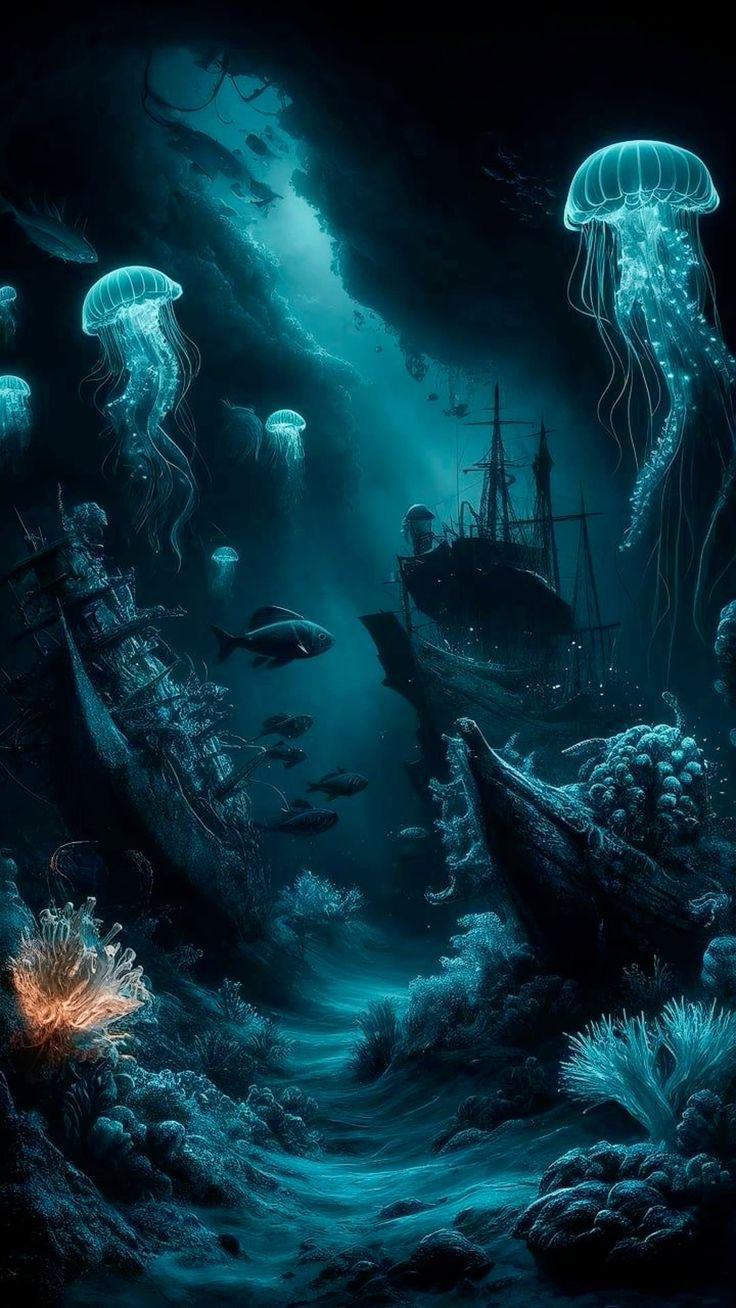Introduction: The Last Great Frontier on Earth
The ocean covers more than 70 percent of our planet, yet much of it remains unexplored. Beneath the waves lies the deep sea — a vast, mysterious world cloaked in perpetual darkness. It begins roughly 200 meters below the surface, where sunlight fades, and extends to the abyssal depths, more than 11,000 meters down. For centuries, people assumed that life could not survive in such extreme conditions. But scientific exploration has revealed a thriving world filled with creatures so bizarre and beautiful that they challenge our very understanding of life on Earth.
Into the Darkness: The Environment of the Deep
The deep sea is one of the most hostile habitats imaginable. Temperatures hover just above freezing, the pressure can be over a thousand times that at the surface, and sunlight is completely absent. Yet, in these harsh conditions, life has not only survived but flourished. From the abyssal plains to the pitch-black trenches, every layer of the deep ocean is home to unique species adapted to survive where humans could not. Instead of sunlight, many organisms rely on chemical energy or feast on “marine snow” — the tiny particles of organic matter drifting down from the surface.
Evolution’s Wildest Creations
To survive in the deep sea, creatures have evolved remarkable adaptations. Some have developed oversized jaws to consume scarce prey, while others use bioluminescence to lure victims or communicate. Transparent bodies, expandable stomachs, light-producing organs, and slow metabolisms are common traits. These adaptations are not just survival mechanisms — they are evolutionary masterpieces, crafted by millions of years of life in the shadows. The diversity found here is so immense that scientists estimate we have only discovered about 10 percent of all deep-sea species.
The Enigmatic Anglerfish
Perhaps the most famous of all deep-sea creatures, the anglerfish looks like a nightmare come to life. With a body built for ambush and a glowing lure extending from its head, it waits patiently for prey to be drawn toward its light. Once within reach, the anglerfish’s razor-sharp teeth snap shut in an instant. Female anglerfish can grow up to a meter long, while males are tiny — often fusing themselves permanently to the female’s body to provide sperm for reproduction. This strange mating method ensures survival in an environment where encounters are rare.
Giants of the Abyss: The Giant and Colossal Squid
For centuries, sailors spoke of monstrous sea creatures capable of pulling ships beneath the waves — the legendary Kraken. These tales were inspired by real animals: the giant squid and its even larger relative, the colossal squid. Growing up to 13 meters in length, these elusive cephalopods have enormous eyes, the size of dinner plates, adapted to detect the faintest glimmers of light in the darkness. Despite their terrifying appearance, they are rarely seen alive. Their existence was confirmed only through deep-sea photography in the early 21st century. Today, they remain symbols of the mysteries that still lurk in the ocean’s depths.
The Haunting Beauty of the Vampire Squid
Despite its sinister name, the vampire squid (Vampyroteuthis infernalis) is more a scavenger than a predator. With its deep red body, webbed arms, and glowing blue eyes, it looks like something out of a fantasy tale. Instead of hunting, it feeds on organic debris drifting from above — a slow, graceful recycler of the deep. The vampire squid can turn itself inside out when threatened, hiding its vulnerable parts and revealing rows of soft spines for protection. It also ejects a cloud of glowing mucus to confuse attackers, a haunting spectacle of bioluminescent defense.
The Gulper Eel: Nature’s Deep-Sea Oddity
The gulper eel, also known as the pelican eel, is one of the strangest creatures found in the ocean abyss. Its enormous mouth, capable of expanding like a balloon, allows it to swallow prey much larger than itself. Its body is long and whip-like, ending in a glowing tip that acts as a lure in the dark. When food is scarce, it can go for long periods without eating, conserving energy in an environment where survival depends on patience. The gulper eel’s bizarre design is a testament to the power of evolution in shaping life under extreme conditions.
The Deep-Sea Dragonfish: Predator of the Black Abyss
Among the deadliest hunters in the deep sea is the dragonfish, a sleek predator equipped with dagger-like teeth and a luminous barbel that dangles from its chin. It uses this glowing appendage to attract prey in the pitch darkness. What makes it even more unique is its ability to produce red light — invisible to most other marine creatures — giving it a hidden advantage in spotting prey that cannot see it coming. Its eerie, translucent skin and glowing body make it one of the most hauntingly beautiful residents of the abyss.
Life Without Sunlight: The Miracle of Hydrothermal Vents
In 1977, oceanographers made a discovery that changed our understanding of life on Earth. Deep in the Pacific Ocean, they found hydrothermal vents — cracks in the seafloor releasing superheated, mineral-rich water. Around these vents existed thriving ecosystems teeming with giant tube worms, clams, crabs, and bacteria. These creatures do not rely on sunlight at all; instead, they live off chemosynthesis, using chemicals from the vent water to create energy. This astonishing discovery proved that life can exist without sunlight, inspiring scientists to consider the possibility of life on other planets, such as Jupiter’s moon Europa or Saturn’s moon Enceladus.
The Transparent Beings: Masters of Disguise
Many deep-sea animals have evolved transparency as a defense mechanism. The glass octopus, for instance, has see-through skin that makes it almost invisible, with only its eyes and digestive organs faintly visible. Similarly, the barreleye fish has a transparent head, allowing it to look upward through its skull to spot prey. These adaptations provide a perfect camouflage in the darkness, where being invisible often means the difference between life and death.
The Gigantic Isopod: The Deep Sea’s Cleanup Crew
At first glance, the giant isopod looks like an enormous underwater insect, but it is actually a distant relative of the woodlouse. These creatures live on the ocean floor, scavenging on dead animals that drift down from above. They can grow up to half a meter long and can survive for months without food. Their tough exoskeletons and slow metabolism make them perfectly suited for a world of scarcity and pressure. Though eerie in appearance, giant isopods play an essential ecological role by recycling nutrients in the deep-sea environment.
Bioluminescence: Lighting Up the Abyss
In the deep sea, where sunlight cannot penetrate, bioluminescence is the language of survival. From tiny plankton to massive jellyfish, countless species generate their own light. They use it for hunting, mating, camouflage, and defense. Some, like the hatchetfish, have glowing bellies that mimic the faint light filtering from above, making them invisible from below. Others, like the flashlight fish, use light to signal to companions or lure prey. These glowing displays turn the darkness into a breathtaking spectacle — an underwater galaxy of living lights.
New Discoveries: The Deep Sea’s Endless Mysteries
Despite advances in technology, more than 80 percent of the ocean remains unexplored. Every expedition brings new revelations — new species, strange behaviors, and ecosystems beyond imagination. In recent years, scientists have discovered glowing jellyfish, sea cucumbers that swim like ballerinas, and even fish that can survive near freezing hydrothermal vents. Each new discovery reminds us that the deep ocean is Earth’s final frontier — a realm that continues to challenge our understanding of biology and the limits of life.
Threats to Deep-Sea Life
Even in this remote and mysterious world, human activities are leaving a mark. Deep-sea mining, plastic pollution, and climate change threaten delicate ecosystems that have existed for millennia. Microplastics have been found in some of the deepest trenches on Earth, and warming oceans are altering deep-sea currents and oxygen levels. Because deep-sea creatures grow slowly and reproduce infrequently, they are especially vulnerable to disturbance. Protecting this hidden realm is crucial, not just for biodiversity but for the health of our entire planet.
Conclusion: The Living Mystery Beneath Us
The deep sea remains one of Earth’s most awe-inspiring frontiers — a place of wonder, terror, and unimaginable beauty. From glowing predators to ghostly scavengers, life in the abyss defies the limits of biology and imagination. Each creature is a reminder of nature’s power to adapt and thrive in even the harshest conditions. As technology continues to advance, we will uncover more secrets from this alien world — and perhaps, one day, understand how these strange beings fit into the grand story of life on our planet. The ocean abyss reminds us that we have not yet seen everything Earth has to offer — and that some of its greatest wonders still lie waiting in the dark.


